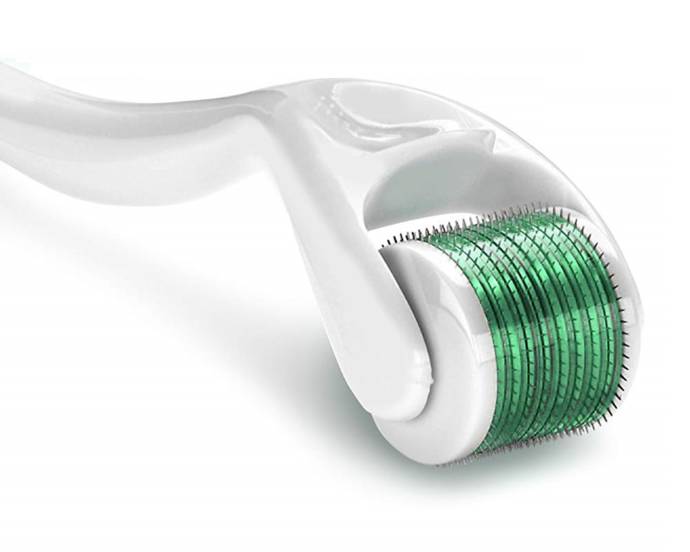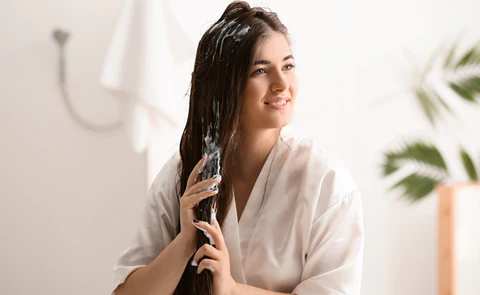Welcome to the new world of hair loss treatments. Originally used to prescribe beauty treatments on the face, microneedling is a cosmetic treatment well known on the aesthetic circuit for many skin beautifying reasons. Now making waves on the hair loss front, there are proven studies that show microneedling combined with hair loss agents can cause five times more effective regrowth.
So what is it?
For those of you who are less acquainted with this beauty method, allow me to enlighten you. The treatment also known as ‘skin needling’ or Collagen Induction Therapy (CIT), microneedling uses ‘micro’-’needles’ to pierce the skin in a noninvasive way, with needles 0.25mm – 0.5mm long.
These tiny pin pricks on the skin are designed to cause, for lack of a better word, ‘wounds’. However not the type of wounds that would cause large amounts of oozing and bleeding to the freshly treated area, but a wound that pierces only the top layer of skin.
The idea behind this is that by piercing the skin you are forcing the body to react to these superficial wounds with its healing agent, collagen.
As you may well know collagen aids in skin cell rejuvenation, it causes wounds to close and heal with new and healthy skin.
Such reasons are why this is a popular beauty treatment for people with scars/acne etc – causing the skin to react and regenerate to ‘fix’ treated areas creating a new wave of growth and stimulation.
How does it work?
So now let’s apply this to a hair loss treatment. If this procedure stimulates the regeneration of cells why wouldn’t it have a positive effect on hair regrowth? Afterall hair is a living cell.
If having this treatment with a professional, you should ask to see credentials as the treatment can be a little more evasive, as they can use a slightly higher needle depth to penetrate the skin dependent on what they think your needs may be.
Professional treatments are advised to be booked 4-6 weekly and no more than that. This is due to the fact that this is a ‘healing’ treatment. The micro wounds created need time to heal to produce the collagen etc, without that time all you are doing is creating more damage to the existing wound and it will more than likely have the adverse effect.
That’s right, you may cause yourself to lose more hair! Remember a professional esthetician will want to review or follow up with you after your treatment to ensure not only that the procedure is going well, but that you are ok. An esthetician will charge approx.
£400 for a course of three sessions, this is not a cheap procedure and due to this many have opted for the at home version.
If trying this at home you must ensure that your microneedling equipment is sterile, stored adequately and disposed of after 15-30 uses.
The derma roller used at home, if you drop it you must dispose of it. The needles will be bent and you cannot put your skin through that kind of trauma.
Ensure that the hair loss area that is about to be treated is clean and wet, wet because it will stop hair from becoming tangled in the roller.
Remember, you as the administer are in control of the pressure applied to your scalp/hair loss area, this should be a gentle amount of pressure – you are not looking to draw blood, only peirce a small hole.
Once confident with your pressure, roll the derma roller back and forth vertically 3-5 times, horizontally 3-5 times and finally diagonally 3-5 times across the area you are treating.
Now you must apply your treatment oil, lotion etc. The reason this technique is so effective is due to the microneedle piercings that have been created. Not only have they now caused a reaction with the collagen protein inside of you, but they are behaving like little drains.
They will absorb 5 times more of your treatment product than if you applied it normally. This is why it is so important for equipment and everything that is coming into contact with the area to be sterile and clean, otherwise you put yourself at the risk of infection.
It is also recommended that you use antiseptic shampoo whilst having treatment. When administering at home the treatment can vary as each individual will react differently, it is recommended that on a 0.25mm needle you can administer every other day however once a week is sufficient enough to start seeing results.
To see best results, use two different needle lengths at different periods throughout the treatment for example, the 0.25mm every other day and a 0.5mm once a month, stimulating a deeper penetration.
Microneedling has proven effective in studies as a way of positively combating male pattern baldness which affects a high percentage of both male and females around the world today.
Does it hurt? Well that is subjective. Like a tattoo, many describe it as a pleasant pain, others describe it as a terrible unbearable pain. Microneedling at home is less painful as you administer the treatment yourself and therefore determine the level of pressure used and needle size.
When having this treatment professionally you are not in control of those factors and the fact that you have the option to use an anesthetic cream and numbing lotion should give you some idea of what to expect.
Like any treatment out there you will need to decide for yourself if the pros outweigh the cons of this procedure. Are you desperate for hair and prepared to try anything to get it? Then you will push through the pain as this treatment is a necessity to achieving your goal.
If you are just toying with the idea and are very aware that you have a low pain threshold, then perhaps this might not be for you, or perhaps start at home.
What are the side effects?
Like with any procedure there are of course side effects. The first and certainly most noticeable is the redness. The redness due to small blood marks, or the redness due to the irritation and inflammation.
This does thankfully subside in a day or so and actually isn’t that distinctive to begin with, more of a ‘hot flush’ colour.
Slight oozing, sometimes especially when the treatment is penetrating a little deeper it will cause the collagen to be produced at such a level to try to block and heal the wounds that you can end up with a little over oozing.
Milia (milk coloured spots), these are small pockets of protein stuck beneath the skin – easily treated and removed with a gentle exfoliant in most cases.
Infection is a possibility with this treatment, as with any procedure that would create an open wound, no matter how small it is. This is why you are given aftercare advice and post treatment instructions from the physician to ensure this doesn’t happen.
Because of the heavy healing process needed to make this a successful treatment, specialists advise that you ensure you have a healthy diet to accommodate that need.
Foods that are high in antioxidants are recommended and the marine protein supplement Viviscal is a popular choice used within the diet whilst undergoing this treatment.
Is microneedling for me?
I guess the real question is, do you have a need for hair regrowth? Is your hair loss due to male pattern baldness? If your answer is yes then i would suggest microneedling is a step in the right direction for you.
Although expensive you are looking at less of a cost than a hair transplant for example, which starts from £1,999, and it is a less invasive procedure. If you have hair loss due to stress, the starting point would be to locate the origin of your stress before seeking treatment.
The only other question would be what do you have to lose? If your answer to that is money, then honestly you aren’t willing to invest in finding a solution for your issue.
It’s like the time old saying, you need to spend money to make money. If you want to see results they don’t come for free, but microneedling when undertaken correctly, has shown positive results in its field which should allow you to feel comfortable with your choice to spend.
This is a procedure that is on the up and up, whether you administer from home or invest in a professional for a more accurate and possibly faster result, the end result will be the same! You will experience hair regrowth.
So i think the only question left that you should be asking yourself is, when should i start?





